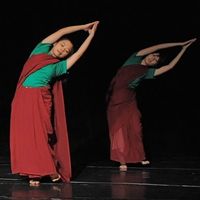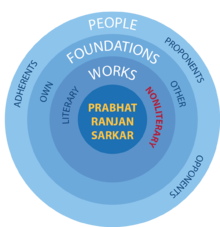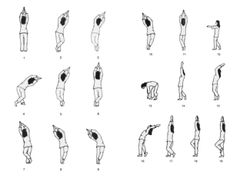Kaosikii nrtya
| This article or section is in the process of an expansion or major restructuring. You are welcome to assist in its construction by editing it as well. If this article or section has not been edited in several days, please remove this template. This article was last edited by Abhidevananda (talk | contribs) 4 years ago. (Purge) |
| Kaosikii nrtya | |
|---|---|
 | |
| Location in Sarkarverse | |
The Kaos'ikii dance or Kaosikii is a dance invented on September 6, 1978 by the Indian philosopher and social reformer Prabhat Ranjan Sarkar aka Shrii Shrii Anandamurti (1921–1990).
Purpose
Sarkar states that he invented the Kaosikii dance primarily with women in mind. However, he also states that the dance is beneficial for both women and men.[1]
According to Sarkar, Kaosikii dance has 22 benefits:[2]
- It exercises all the glands and limbs from head to foot.
- It increases longevity.
- It makes for easy delivery.
- The spine will become flexible.
- Arthritis of the spine, neck, waist and other joints will be removed.
- Gout in the spine, neck, hands and waist will be lost.
- The mind becomes strong and sharp.
- Irregularities in menstruation will be cured.
- Glandular secretions will become regulated.
- Troubles in the bladder and urethra will be cured.
- It gives control over the limbs.
- It adds charm and shine to the face and skin.
- It removes wrinkles.
- It removes lethargy.
- It cures insomnia.
- It cures hysteria.
- Fear complexes will be removed.
- Hopelessness will be lost.
- It helps in self-expression and develops one’s potentiality.
- Spinal pain, piles, hernia, hydrocele in men, nervous pain, nervous disability will be cured.
- It cures kidney and gall bladder troubles, gastric trouble, dyspepsia, acidity, dysentery, syphilis, gonorrhoea, obesity, thinness and liver diseases.
- It increases the capacity to work until 75-80 years of age.
How to perform
Ideation
Sarkar explains the ideation to be maintained while practicing Kaosikii dance as follows:
The two hands upraised and folded together represent, "Now I am trying to establish a link with Parama Puruśa." Both hands bending to the right indicate, "I know the right way to request You." The bending of the body should be at a 45-degree angular projection. The leftward movement represents, "I know how to fulfill Your demands." The movement of bending in front suggests complete surrender. The backward bending represents, "I am ready to face all troubles that may come." The last tá, tá represents, "O Lord, I repeat Your rhythm."
References
Footnotes
Citations
- ^ Anandamurti, Shrii Shrii (1984). "Táńd́ava and Kaośikii" published in Ananda Vacanamrtam Part 22 Ananda Marga Publications.
- ^ Anandamurti, Shrii Shrii (1978). "The Dance of the Expansion of Mind – Excerpt A" published in The Awakening of Women (a compilation) Ananda Marga Publications.
- ^ Anandamurti, Shrii Shrii (1979). "Dances and the Path of Vidyá" published in Ananda Vacanamrtam Part 12. Ananda Marga Publications.
Sources
- Anandamurti, Shrii Shrii (1979) Ánanda Vacanámrtam, Part 6 Kolkata: Ananda Marga-Ananda Printers
- Anandamurti, Shrii Shrii (Ac. Vijayananda Avt. Editor (1994-2) Discourses on Tantra, vol. 2 Kolkata: Ananda Marga-Ananda Printers ISBN 81-7252-112-X
- Womenswelfare.net (2012) "Kaoshikii: meanings and benefits" Ananda Marga Publications retrieved 25 October 2013

